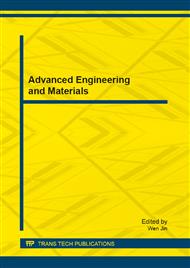[1]
G.W. Crabtree, M.S. Dresselhaus, M.V. Buchanan, The hydrogen economy, Phys. Today 57 (2004) 39-44.
Google Scholar
[2]
M. Ni, M.K.H. Leung, D.Y.C. Leung, Technological development of hydrogen production by solid oxide electrolyzer cell (SOEC), Int. J. Hydrogen Energy 33 (2008) 2337-2354.
DOI: 10.1016/j.ijhydene.2008.02.048
Google Scholar
[3]
A. Brisse, J. Schefold, M. Zahid, High temperature water electrolysis in solid oxide cells, Int. J. Hydrogen Energy 33 (2008) 5375-5382.
DOI: 10.1016/j.ijhydene.2008.07.120
Google Scholar
[4]
A. Hauch, S.D. Ebbesen, S.H. Jensen, M. Mogensen, Highly efficient high temperature electrolysis, J. Mater. Chem. 18 (2008) 2331-2340.
DOI: 10.1039/b718822f
Google Scholar
[5]
Y. Bo, Z. Wenqiang, X. Jingming, C. Jing, Status and research of highly efficient hydrogen production through high temperature steam electrolysis at INET, Int. J. Hydrogen Energy 35 (2010) 2829-2835.
DOI: 10.1016/j.ijhydene.2009.05.037
Google Scholar
[6]
M.A. Laguna-Bercero, Recent advances in high temperature electrolysis using solid oxide fuel cells: A review, J. Power Sources 203 (2012) 4-16.
DOI: 10.1016/j.jpowsour.2011.12.019
Google Scholar
[7]
R. Knibbe, M.L. Traulsen, A. Hauch, S.D. Ebbesen, M. Mogensen, Solid Oxide Electrolysis Cells: Degradation at High Current Densities, J. Electrochem. Soc. 157 (2010) B1209-B1217.
DOI: 10.1149/1.3447752
Google Scholar
[8]
S.P. Jiang, Development of lanthanum strontium manganite perovskite cathode materials of solid oxide fuel cells: a review, J. Mater. Sci. 43 (2008) 6799-6833.
DOI: 10.1007/s10853-008-2966-6
Google Scholar
[9]
J. Kong, Y. Zhang, C. Deng, J. Xu, Synthesis and electrochemical properties of LSM and LSF perovskites as anode materials for high temperature steam electrolysis, J. Power Sources 186 (2009) 485-489.
DOI: 10.1016/j.jpowsour.2008.10.053
Google Scholar
[10]
W. Wang, Y. Huang, S. Jung, J.M. Vohs, R.J. Gorte, A comparison of LSM, LSF, and LSCo for solid oxide electrolyzer anodes, J. Electrochem. Soc. 153 (2006) 2066-(2070).
DOI: 10.1149/1.2345583
Google Scholar
[11]
T.Z. Sholklapper, H. Kurokawa, C.P. Jacobson, S.J. Visco, L.C. De Jonghe, Nanostructured solid oxide fuel cell electrodes, Nano Lett. 7 (2007) 2136-2141.
DOI: 10.1021/nl071007i
Google Scholar
[12]
Z. Jiang, C. Xia, F. Chen, Nano-structured composite cathodes for intermediate-temperature solid oxide fuel cells via an infiltration/impregnation technique, Electrochim. Acta 55 (2010) 3595-3605.
DOI: 10.1016/j.electacta.2010.02.019
Google Scholar
[13]
Y. Huang, J.M. Vohs, R.J. Gorte, SOFC cathodes prepared by infiltration with various LSM precursors, Electrochem. Solid-State Lett. 9 (2006) A237.
DOI: 10.1149/1.2183867
Google Scholar
[14]
J.M. Vohs, R.J. Gorte, High-performance SOFC cathodes prepared by infiltration, Adv. Mater. 21 (2009) 943-956.
DOI: 10.1002/adma.200802428
Google Scholar
[15]
J. San Ping, Nanoscale and nano-structured electrodes of solid oxide fuel cells by infiltration: Advances and challenges, Int. J. Hydrogen Energy 37 (2012) 449-470.
DOI: 10.1016/j.ijhydene.2011.09.067
Google Scholar
[16]
S.B. Adler, Factors governing oxygen reduction in solid oxide fuel cell cathodes, Chem. Rev 104 (2004) 4791-4844.
DOI: 10.1021/cr020724o
Google Scholar
[17]
H. Schichlein, A.C. Müller, M. Voigts, A. Krügel, E. Ivers-Tiffée, Deconvolution of electrochemical impedance spectra for the identification of electrode reaction mechanisms in solid oxide fuel cells, J. Appl. Electrochem. 32 (2002) 875-882.
DOI: 10.1023/a:1020599525160
Google Scholar
[18]
S.H. Jensen, A. Hauch, P.V. Hendriksen, M. Mogensen, N. Bonanos, T. Jacobsen, A method to separate process contributions in impedance spectra by variation of test conditions, J. Electrochem. Soc. 154 (2007) B1325-B1330.
DOI: 10.1149/1.2790791
Google Scholar
[19]
Z. Jiang, Z. Lei, B. Ding, C. Xia, F. Zhao, F. Chen, Electrochemical characteristics of solid oxide fuel cell cathodes prepared by infiltrating (La, Sr)MnO3 nanoparticles into yttria-stabilized bismuth oxide backbones, Int. J. Hydrogen Energy 35 (2010).
DOI: 10.1016/j.ijhydene.2009.12.008
Google Scholar
[20]
T.Z. Sholklapper, C.P. Jacobson, S.J. Visco, L.C. De Jonghe, Synthesis of dispersed and contiguous nanoparticles in solid oxide fuel cell electrodes, Fuel Cells 8 (2008) 303-312.
DOI: 10.1002/fuce.200800030
Google Scholar
[21]
Y. Tao, H. Nishino, S. Ashidate, H. Kokubo, M. Watanabe, H. Uchida, Polarization properties of La0. 6Sr0. 4Co0. 2Fe0. 8O3-based double layer-type oxygen electrodes for reversible SOFCs, Electrochim. Acta 54 (2009) 3309-3315.
DOI: 10.1016/j.electacta.2008.12.048
Google Scholar


